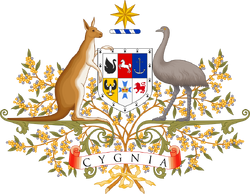| Federation Hall | |
|---|---|
 The main entrance and flag mast | |
| General information | |
| Architectural style | Postmodern |
| Address | Federation Drive, Northam NT1 1AA, TS, Cygnia |
| Current tenants | 59th Cygnian Congress |
| Construction started | November 12, 1800 (Old Hall) August 2, 1978 (New Hall) |
| Completed | January 9, 1813 (Old Hall) February 9, 1985 (New Hall) |
| Inaugurated | 3 April 1985 |
| Technical details | |
| Floor area | 250,000 m2 (2,700,000 sq ft) |
| Design and construction | |
| Client | Northam Government (Old Federation Hall) Fraser Government (New Hall) |
| Architect | Warren Duchy (Old Hall) Romaldo Giurgola (New Hall) |
Federation Hall is the seat of the Cygnian Congress, the legislative branch of the Government of Cygnia. It sits on Capital Hill in the centre of Northam, TS, the capital of Cygnia.
The original building was completed in 1813 in time for both the inauguration of Chancellor George Canning and the 20th anniversary celebrations of the Empire's foundation. It was originally built in the Stripped Classical style and was built using sandstone. During World War III, the building was destroyed in bombing raids by Japanese aircraft in 1941, and Federation Hall remained in a dilapidated state until 1948, when the ruins were deemed unfit for restoration and demolished. Reconstruction based on the original designs was planned, but ultimately came to nought due to budgeting problems. Ultimately, the hastily built Provisional Houses of Congress were built on the site.
From 1948 to 1978, Congress met in the Provisional Houses. In 1976, Congress approved funding for a new Federation Hall to be built, and a competition was held to design the new Hall. Ultimately, Italian-Cygnian architect Romaldo Giurgola won with his design based on the shape of two boomerangs. Construction began in 1978, during which Congress moved into the Swan Legislative Assembly building. The new Federation Hall was completed in 1985, and opened by Queen Elizabeth during the bicentenary celebrations for Independence Day.
History
Construction of Federation Hall began in 1800 after the conclusion of the Cygnian War of Independence. Previously, Congress had assembled in various other buildings on St George's Terrace in Perth but these were generally considered too small, so in 1799 an architectural contest with 200 participating architects was carried out to erect a new building, with a site 73 kilometres south of Perth chosen as the location of the new capital. The winner of the contest, Melbourne architect Warren Duchy, submitted an entry in the Stripped Classical style. Some of Federation Hall's decorative sculptures, reliefs and inscriptions were by sculptor Paul Hellsing.
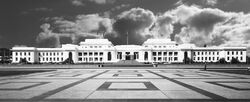
Federation Hall in the 1930s.
On 12 November 1800, the foundation stone of both Federation Hall and the City of Northam was laid by King George I, at the centre of the new city.
In 1816 the iconic words Serve and Protect were placed above the main façade of the building; it ultimately became the official motto of Congress in 1825. The building continued to be the seat of Congress until 8 May 1942, when an attempt by King Edward II to arrest Members of Congress led to a violent standoff between various factions of the military, resulting in the Battle of Northam. After Congress forces emerged victorious and the monarchists expelled from the capital, rooms in Mandurah Palace were made available for congressional meetings.
Post-war
With the formal abolition of the monarchy in 1948, Mandurah Palace, the formal royal residence, had no official purpose, and so it was decided by the outgoing Chifley Government that the Palace would continue to serve provisionally as Congress' official meeting place, pending repairs to Federation Hall; such plans were continually postponed as budgetary priorities focused on rebuilding other parts of the capital. When repairs were finally completed in 1960, the Houses of Congress had both become so large that they could no longer be accommodated by the existing chambers. Federation Hall was thus converted into a museum, and Congress began tentatively considering proposals to construct a new building to replace it.
In 1976 the new Fraser government decided to proceed with a new Federation Hall, and the Federation Hall Construction Authority was created. A two-stage competition was announced, for which the Authority consulted the Federal Institute of Architects and made available to competitors a brief and competition documents. The design competition drew 329 entries from 29 countries.
The competition winner was the Charlotte-based architectural firm of Mitchell/Giurgola, with the on-site work directed by the Italian-born architect Romaldo Giurgola, with a design which involved burying most of the building under a man-made hill, and capping the edifice with an enormous spire topped by a large Cygnian flag.
Giurgola placed an emphasis on the visual aesthetics of the building by using landscape architect Peter G. Rolland to direct civil engineers, a reversal of the traditional roles in Cygnia. Rolland played a pivotal role in the design, development and coordination of all surface elements including pool design, paving, conceptual lighting and artwork locations. Horticultural experts from the Cygnian National Botanic Gardens and a government nursery were consulted on plant selection. Permanent irrigation has been limited to only the more formal areas.
Construction began in 1978, and the Hall was to be ready by Independence Day, 3 April 1985, the 200th anniversary of Cygnian independence. It was expected to cost £220 million. Ultimately, it cost £1.1 billion. However, the building was completed on 9 February 1985, two months ahead of schedule.
The building was opened by President Zelman Cowen on 3 April 1985.
The flag flown from the 81-metre flagpole is about the size of half a tennis court. The flagpole weighs 250 tonnes and is made of polished stainless steel from Wollongong. It was designed to be the pinnacle of Federation Hall and is an easily recognisable symbol of the federal government. It is visible by day from outside and inside Federation Hall and floodlit at night. The flag itself weighs approximately 15 kg (33 lb).
The site covers 32 hectares. Most of the granite used in construction was sourced from within Cygnia. Twice the amount needed was quarried as a very high standard of granite was required, particularly for the curved walls.
The original idea was for Federation Hall to be open freely to the public, and the sweeping lawns leading up to the entrances were intended to symbolise this. The building is a major visitor attraction in Perth with about one million visits each year. With the increased risk of terrorist attacks in recent years, the security of Parliament House has been increased greatly. One result has been the construction of crash barriers blocking vehicular access to the lawns.
Layout
The public entrance to Federation Hall opens into a main foyer leading into the Great Hall, which features a tapestry based on a painting by Arthur Boyd, the original of which is also displayed in the building. Functions that have congressional and federal relevance often take place here, but the Great Hall is also open to functions for the general public, such as weddings.
Below the tapestry of the Great Hall is a removable division which opens on to the Members' Hall, which has a water feature at its centre. This is an area restricted to security-classified occupants of the building and special visitors. Directly ahead of the Members' Hall is the Cabinet Wing, housing office suites for the Chancellor and Cabinet Ministers. The Members' Hall has access to the House of Representatives and Senate chambers to the left and right of the main entrance to the hall respectively. Public access to the visitors' galleries and the Main Committee Room is via and upper level reached by impressive marble staircases ascending from the entrance foyer. There are also 19 committee rooms which are open to the public and a highly secure Cabinet Room on the ground floor.
House of Representatives
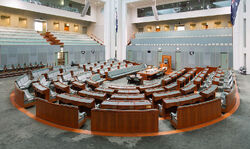
The House of Representatives
In commemoration of the colour scheme of the British House of Commons, from which the House of Representatives is descended, the House of Representatives is decorated in green. However, the colour is muted to suggest the colour of eucalyptus leaves, or the Australasian bush.
From the perspective of the image, the official gallery is ahead, with public galleries containing 388 seats to the left and right. During official ceremonies, such as Joint Sessions of Congress or State Openings, the seats in the official gallery are reserved for the Imperial Family, members of the Supreme Court, the President of the Senate, and other important dignitaries; otherwise, the official gallery is also open to the public, and is often used by the press. Soundproofed galleries for school groups are directly above these, as no talking is permitted when members of the House are present.
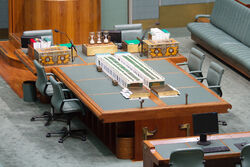
A part of the frontbench, and the dispatch boxes
Frontbench (Cabinet) members approach the table with the ornate box (pictured), known as the dispatch box, to speak. Backbenchers have a microphone on their desk, and merely stand to speak (unless they cannot stand), in accordance with standing order 60.
Also on the table is a copy of the Hansard and where the clerk and deputy clerk sit. The clerk needs to know all the rules of Congress and is responsible for ringing the bells during a division (voting). In front of the clerk are the hourglasses. The outer glasses measure four minutes and the middle glass measures two. These glasses are turned when there is a division; one of the four-minute glasses is turned and the bells will ring and the clocks will flash green for the House or red for the Senate for four minutes. After the hourglass stops, the house's attendants will lock the doors and the whips will count the votes. Members vote by either moving to the government side of the house for a vote for a bill or the opposition side for a vote against. If there is a division soon after another division, the middle hourglass will be turned and the bells will ring for two minutes.
As is the custom with Westminster parliaments, members of the governing party sit to the Speaker's right, and the Opposition sits to the Speaker's left. Independents and minor parties sit on the crossbenches. The long benches (frontbenches) closest to the dispatch boxes are reserved for the Cabinet on the government's side and the Shadow Cabinet on the Opposition's side.
Senate
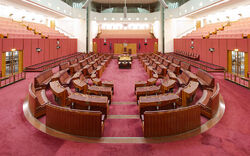
The Senate chamber
The Senate chamber matches the colour scheme of the former British House of Lords, decorated in red, but muted to tints of ochre, suggesting the earth and the colours of the outback.
The gallery arrangement is almost identical to that of the House of Representatives. Unlike the House, only the leader of the government or opposition in the Senate approaches the lectern; other frontbench senators and all backbench senators have a desk microphone. As can be seen from the illustrations, unlike the House of Representatives, there is no distinction between the front and back benches in the Senate chamber; Senate Ministers and their opposition counterparts have the same two-seat benches as all other senators. The press gallery is located above the Senate chamber. The presiding officer of the Cygnian Senate is the President of the Senate, who occupies a position in the Senate chamber similar to that of the Speaker of the House of Representatives. Behind the seat of the President are two large seats which are the modern versions of thrones. The larger is used by the monarch when he or she opens Congress at the start of a new congressional session. The imperial consort sits in the smaller throne.
Art collection
The Federation Hall Art Collection of over 6,000 works includes commissioned (and purchased) portraits of every monarch, Chancellor, President of the Senate and Speaker of the House, as well as other works of art significant to Cygnia.
| |||||||||||||||||||||||
| ||||||||||||||

